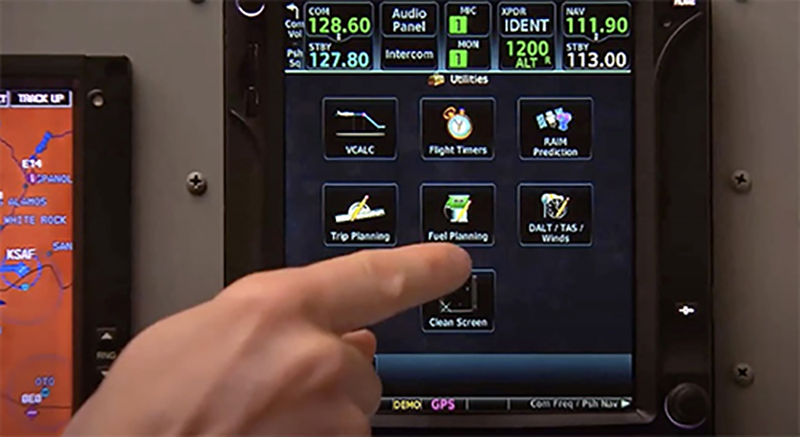PROS OFFER DISINFECTING TIPS
GARMIN, MYGOFLIGHT SUGGEST CAREFUL CLEANING AND AVOIDING AMMONIA-BASED SOLUTIONS
By David Tulis
 Experts explain the correct way to clean your avionics, instrument panels, and personal devices to keep them germ-free and functioning properly.
Experts explain the correct way to clean your avionics, instrument panels, and personal devices to keep them germ-free and functioning properly.
Garmin suggests a careful approach and special procedures to clean and disinfect electronics. Image courtesy of Garmin via YouTube.
Garmin’s Joey Ferreyra, who helped outfit avionics for the 2019 AOPA Sweepstakes Super Cub, said “using the wrong cleaner can be bad news for avionics.”
The company published a service advisory that informs pilots how to clean and disinfect touch screens and function knobs on panel-mounted avionics with specific guidance about reducing the spread of disease while preserving the integrity of the avionics devices.
To begin with, aircraft owners and pilots should use a lint-free cloth instead of paper products—which can mar surface displays— and a cleaner that is specified “safe for anti-reflective coatings.”
Garmin and other avionics companies advise pilots to avoid ammonia-based cleaners because the chemical will harm the anti-reflective coatings on aviation display lenses.
The G1000 series has a special anti-reflective coating found on many other Garmin products that is “very sensitive to skin oils, waxes and abrasive cleaners. Cleaners containing ammonia will harm the anti-reflective coating,” the company advised on the G1000NXi support page.
Disinfecting solutions of 70 percent isopropyl alcohol are acceptable and provide the “best combination of bactericidal effectiveness and equipment safety” as long as they don’t contain ammonia. The surface must remain wet for at least 30 seconds, Garmin notes.
Other exposed surfaces like knobs, buttons, and bezels, can be cleaned with a damp cloth moistened with soap and water, but pilots should remove the soap or soap residue to prevent buttons and knobs from gumming up or becoming slippery. The company reminded pilots that “many aviation products are not rated as waterproof. Spraying or wetting the units to the extent where moisture could go beyond the exterior surfaces could damage the unit.” Garmin also doesn’t recommend bleach-based cleaners, or other harsh chemicals.
Some panel-mounted touch-screen avionics have a special screen-cleaning function button that “locks” the unit during in-flight cleaning operations to remove fingerprint smudges. A video provides additional guidance for the Garmin GTN series of avionics.
Aircraft and portable devices also require attention. Aviators who are not grounded by local stay-at-home orders during the coronavirus pandemic can come in contact with germs on fuel pumps, point-of-sale touch pads, and pilot lounge computers.
MyGoFlight’s Dominic “Nic” Martinez suggested pilots adhere to the most recent Centers for Disease Control and Prevention advisories and add a “common-sense approach to helping to protect ourselves, coworkers, friends, and family.”
He said pilots could start by creating a space in their flight bags or luggage to locate protective and cleaning gear quickly. Travel-sized liquid disinfectants are handy when water is unavailable, Martinez said. “You will want to use them often, and prior to entering the cockpit.”
He also advised pilots to “wipe down all surface areas with a disinfecting cleaner like Clorox wipes prior to and just after entering the cockpit, and spend particular attention to areas you will touch often.”
Tablets, phones, and avionics mounts should also be cleaned prior to handling. Martinez said travel-sized disinfectant wipes for this purpose are convenient, effective, and easy to dispose of, but “don’t forget to bring a trash bag to dispose of the wipes you may have used in flight.”
Many portable devices have special chemical-resistant glass over their touch-screen displays. They come with similar precautions to avoid ammonia-based cleaners that can damage their surfaces.
MyGoFlight sells a line of protective ArmorGlas products for electronic flight bags and tablets that contain an “oleophobic layer” that reduces oils and grime and adds anti-glare protection for improved visibility.
Martinez said it was safe to use a mild dish detergent on silicone components including suction cups for handheld avionics and point-of-view cameras. They can be cleaned and then dried with a soft cloth. “UV light is very aggressive on the silicone, so you don’t want to leave it out in the sun,” Martinez noted. He recommended storing interior mounts out of sunlight to preserve their integrity.
He said face masks, protective eyewear, and disposable gloves can be effective when pilots are required to sit in close quarters with other pilots or when they are carrying passengers. However, Martinez cautioned them to defer to their safety officers first, and to follow their directives to help “pilots, families, and crews stay safe and stay healthy”
during the ongoing coronavirus crisis.

David Tulis
Associate Editor Web/ePilot
AOPA Associate Editor Web/ePilot David Tulis joined AOPA in 2015 and is a private pilot with single-engine land and sea ratings and a tailwheel endorsement. He is also a certificated remote pilot and co-host of the award-winning AOPA Hangar Talk podcast. David enjoys vintage aircraft and photography.
Reprinted with permission of the Aircraft Owners and Pilots Association



